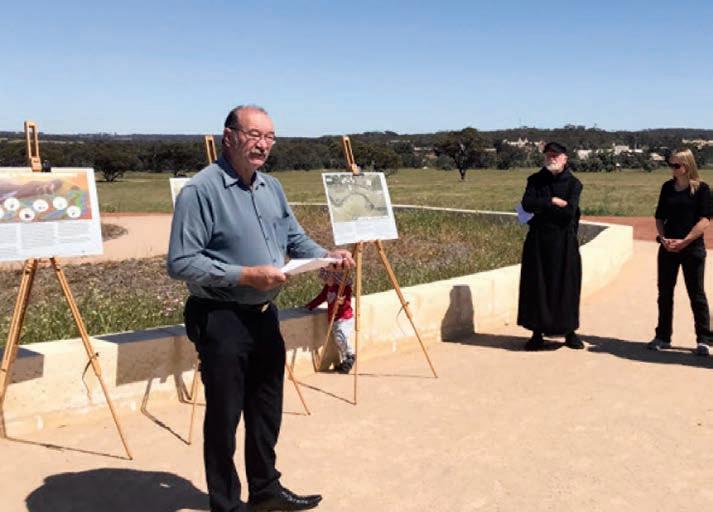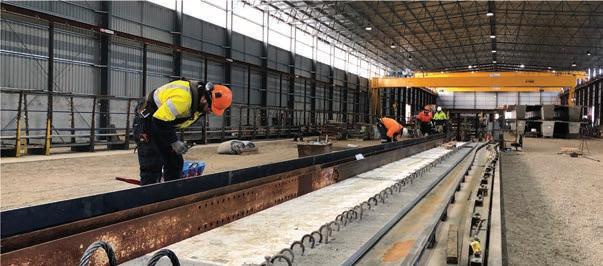
8 minute read
Great Northern Highway
WHEATBELT WORKS
AS A MAJOR FREIGHT ROUTE TO THE NORTH OF WESTERN AUSTRALIA, THE GREAT NORTHERN HIGHWAY CARRIES SOME OF THE COUNTRY’S LARGEST LOADS. WITH UPGRADES HAPPENING IN STAGES SINCE THE 1990S, ROADS & INFRASTRUCTURE CATCHES UP ON THE LATEST WORKS.
In the early 1990s Norm Fox, now Main Roads Program Director, sought funding for a road he described as narrow, winding and unsafe. This road is known as the Great Northern Highway and spans from Perth up to Wyndham, in the north of Western Australia.
In 1990, Mr. Fox was the Regional Manager at Main Roads for the Wheatbelt North region.
Following Mr. Fox’s push for upgrades a series of works were completed throughout the 1990s. In the mid to late 2000s another large program of works was undertaken which saw bridges constructed, widening and general road upgrades along the route.
The latest set of works began in 2014, and the section has nine major construction packages, seven of which are completed.
The remaining two packages, the Walebing and Wubin upgrades are set to be complete by late 2020.
Finally, the Bindoon Bypass will be the last section of the road to be upgraded. This is currently in the planning stage.
The Muchea to Wubin section of Great Northern Highway is 218 kilometres long and affects many stakeholders, transport operators, road users and adjacent landowners who, according to Mr. Fox, were all united by the desire for a better road. Main Roads has partnered with ARUP and Jacobs in an integrated team to undertake the planning, design and construction supervision of this section of highway.
The project team was awarded the Australian Institute of Project Management – 2019 Project of the Year and the National Regional Project of the Year.
CONTRACTS WITH A DIFFERENCE The decision to split the work in to nine packages was to ensure work would be available to smaller contractors.
“We wanted to make sure mid-tier contractors and smaller businesses would be able to tender for the works. This was to give back to Western Australian businesses,” Mr. Fox says.
In a first for Main Roads, the contract for the Pithara section was based on a New Engineering Contract (NEC3) contract. NEC3 is a family of contracts which focuses on project management principles and practices within a relationship style contracting model.
“NEC3 is a structured collaborative style of contracting, focused on early intervention and a shared resolution of problems. You can pick one of the six or so
models available in the suite,” Mr. Fox says.
“The option we chose is a blend of a collaborative contract style, like alliance contracts, and a construct only contract style. It has a risk reward regime associated with it and it has strong obligations on both parties to notify and resolve variations quickly.”
Mr. Fox says the project planning was very successful and Main Roads will likely look at incorporating more NEC3 contracts in the future.
In another first, the overall program of Great Northern Highway works was assessed by the Infrastructure Sustainability Council of Australia (ISCA).
“The integrated project team of ARUP, Jacobs and Main Roads worked hard to identify sustainability opportunities throughout the program and to implement them into the delivery contracts,” Mr. Fox says.
“These were construct only contracts and it was the first time Main Roads had written sustainability requirements into that form of contract.”
The ISCA Infrastructure Sustainability Rating Scheme evaluates the sustainability performance of all aspects of infrastructure development including governance, economic, environmental and social. The project achieved an ‘Excellent’ sustainability design rating from ISCA.
“That requires contractors to provide us with evidence of the sustainability initiatives they have put in place. We have worked with them on projects to highlight sustainable practices they were already using and to record more of them,” Mr. Fox says.
BINDOON BYPASS As the last remaining works in this section of Great Northern Highway the Bindoon Bypass will span 66 kilometres around the town of Bindoon, with works split into northern and southern sections.
The alignment for the bypass was chosen to minimise the impacts on environmental reserves surrounding the area. “The northern section has an existing road reserve with very high biodiversity values and we have aligned the road out of the road reserve and have run it parallel, in cleared paddocks,” Mr. Fox says.
much less environmental impact.” “There are significant ecological communities in the area and nesting and foraging sites for Carnaby’s Cockatoos. Choosing an alignment around those areas minimised the impacts the project would have on biodiversity,” Mr. Fox says.
The southern section of the Bindoon Bypass is subject to a Public Environmental Report under the Environmental Protection Act in WA, with a decision pending in May 2021.
Mr. Fox says funding for the Bindoon Bypass has been approved. Planning and land acquisition are continuing while the Environmental Clearances are obtained for the southern section, with no date set for construction yet.
Originally it was proposed to upgrade the existing highway, with an eastern bypass of Bindoon however during planning a major challenge was posed by the Bindoon Hill which the existing highway crosses.
“We did a 53.5 metre road train trial with both a quad and triple on that hill and vehicles got down to speeds of eight kilometres on the way up. We also found the geometry wasn’t suitable, so based on that trial we decided to investigate a new alignment,” Mr. Fox says.
“A detailed alignment study was done and, in the end, the western alignment was chosen. The choice for the western alignment was mainly driven by the terrain and by social considerations.”
SUPPORTING COMMUNITY The Great Northern Highway not only serves the Wheatbelt region of WA but is the key link as a major freight route to many towns and mining areas in the north.
Construction and upgrades on the Great Northern Highway so far have centred on improving the route for drivers and also for communities along the road.
New Norcia is one of these towns, situated in the middle of the Wheatbelt. The town is the only operating Monastic town left in Australia which attracts 75,000 visitors yearly. Established in 1847, the streets are dotted with castle-like buildings.
“New Norcia is a place of peace and tranquillity; it houses many old artefacts. When the settlers came over in the 1800s, they brought artefacts from the 1600s and beyond. Having a major freight route situated through the middle of town wasn’t ideal, so the opportunity to create a bypass
Main Roads WA Program Director Norm Fox making a speech at the opening of the New Norcia Bypass.

The new northbound overtaking lane as part of the Miling Bypass.

was really important,” Mr. Fox says.
The first two contracts were at New Norcia and Miling Straight and were completed in 2017 and 2018.
For these projects Main Roads set target levels for employment of Aboriginal peoples in Western Australia.
These targets were set for both individual employment and procurement of business. Mr. Fox says these projects achieved effective results.
The same principal was applied on the Pithara and Miling Bypass projects, which were both completed in 2019.
Mr. Fox says these projects also saw good results.
“For the Muchea North project, which is due to finish in August, we worked with the contractor WBHO who approached us with a proposal to subcontract work to an Aboriginal business on a risk-reward basis,” Mr. Fox says.
“This meant that if it ran under cost the contractor and Aboriginal business would share in the savings and if it went over, they would share in the losses. The level of Aboriginal engagement achieved there was very successful.”
Aboriginal team members were able to obtain 52 certificates as part of the project and two trainees were taken on by the main contractor. FINAL STAGES The upgrade in Wubin is ongoing, with completion expected in September. This upgrade includes the realignment of the main intersection which will provide an area large enough for triple road trains to turn south towards Perth.
Walebing works to construct four kilometres of new highway and upgrade
Earthworks at Muchea North. two intersections are also progressing well. These are expected to be complete in October.
From there the final section to construct will be the Bindoon Bypass. Once upgraded Mr. Fox says the Great Northern Highway will be safer and enable improved freight efficiency with the ability to bring triple road trains right down to Muchea.

Proudly Providing Precast Concrete Solutions to the Civil Construction Industry


We pride ourselves on working with our clients to provide quality products to specification, to schedule and within budget.

Our purpose built manufacturing facility specialises in all prestressed and precast concrete products including T-Beams, L-Beams, PSC Planks, PSRC Piles, Headstocks and
columns.
We offer:
Large scale pre tensioning casting beds and capacity for full mould development for bespoke precast concrete elements
Large lift capacities and transport solutions Ancillary works such as anti-graffiti coating and specialist treatments Barrier rail and hand rail fabrication and installation A team of Drafters, Engineers, Technical Specialists and Designers
We are VicRoads prequalified to R3, B3 and F20, RMS prequalified to C2 Complex prestressed concrete products. We hold ISO certifications to 9001 (Quality), 14001 (Environment) and 4801 and 45001 (Safety).










